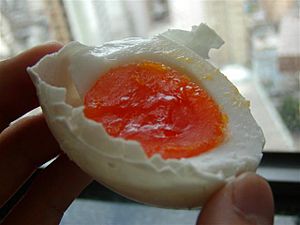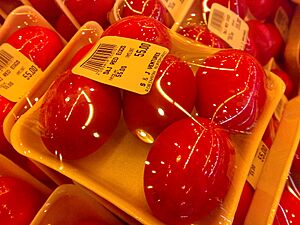Salted duck egg facts for kids
 |
|
| Place of origin | China |
|---|---|
| Main ingredients | Duck Egg in brine |
| Salted duck egg | |||||||||||||
|---|---|---|---|---|---|---|---|---|---|---|---|---|---|
| Chinese name | |||||||||||||
| Traditional Chinese | 1. 鹹鴨蛋 2. 鹹蛋 |
||||||||||||
| Simplified Chinese | 1. 咸鸭蛋 2. 咸蛋 |
||||||||||||
| Jyutping | 1. haam4 aap3 daan6 2. haam4 daan6 |
||||||||||||
| Hanyu Pinyin | 1. xiányādàn 2. xiándàn |
||||||||||||
| Literal meaning | 1. salted duck eggs 2. salted eggs |
||||||||||||
|
|||||||||||||
| Alternative Chinese name | |||||||||||||
| Traditional Chinese | 鹹蛋 | ||||||||||||
| Simplified Chinese | 咸蛋 | ||||||||||||
| Literal meaning | salted eggs | ||||||||||||
|
|||||||||||||
| Burmese name | |||||||||||||
| Burmese | ဆားဘဲကြက်ဥ | ||||||||||||
| Vietnamese name | |||||||||||||
| Vietnamese | trứng vịt muối hột vịt muối |
||||||||||||
| Thai name | |||||||||||||
| Thai | ไข่เค็ม (khị khĕm; Literal meaning: salted egg) | ||||||||||||
| Malay name | |||||||||||||
| Malay | telur masin | ||||||||||||
| Indonesian name | |||||||||||||
| Indonesian | telur asin | ||||||||||||
| Filipino name | |||||||||||||
| Tagalog | itlog na maalat itlog na pula ebun malat ginamos nga itlog |
||||||||||||
| Khmer name | |||||||||||||
| Khmer | ពងទាប្រៃ | ||||||||||||
A salted duck egg is a special kind of egg from ducks. It's a popular food in East Asian countries. People make these eggs last longer by soaking them in salty water, called brine. They can also pack each egg in a damp, salty charcoal mixture.
You might find these eggs in Asian stores. Sometimes they are still covered in a thick layer of salted charcoal paste. Other times, the paste is removed, and the eggs are wrapped in plastic. After the salt curing process, salted duck eggs have a unique smell. The egg white becomes like jelly, and the yolk is firm and round. It has a bright orange-red color.
Salted duck eggs are usually boiled or steamed. Then, they are peeled and eaten. They can be a side dish with congee (a type of rice porridge). They are also cooked with other foods to add flavor. The egg white tastes very salty. The orange-red yolk is rich and fatty, but less salty. This special yolk is very popular. In Chinese mooncakes, it is used to look like the moon.
You can also make salted eggs from chicken eggs. However, they will taste and feel a bit different. The yolk will not be as rich.
In the Philippines, salted eggs are made in a similar way. They are often dyed red. This helps people tell them apart from fresh duck eggs. In the Philippines, they are called 'itlog na pula,' which means 'red-colored egg.'
How Salted Duck Eggs Are Made
The Pateros Method
One popular way to make salted eggs is called the Pateros method. This method is used in the Pateros area of the Philippines. First, people mix clay (from ant hills or termite mounds), table salt, and water. They use a ratio of 1 part clay, 1 part salt, and 2 parts water. They mix it until it is smooth and thick, like cake batter.
Fresh, uncooked eggs are dipped one by one into this mixture. Then, they are packed in batches of 150 eggs. These batches go into wooden boxes that are lined with newspaper. The boxes are about 10x12x18 inches (25x30x46 cm). The whole batch is then lightly wrapped in newspapers. This helps to keep the eggs from drying out too quickly.
The eggs are stored indoors at room temperature. They cure for 12 to 14 days. During this time, the salt moves into the eggs through a process called osmosis. Curing can last up to 18 days. This makes the eggs last longer, up to 40 days. But usually, 12 to 14 days is enough.
After curing, the eggs are cleaned by hand with water and a brush. Then, they are ready to be boiled. They are boiled in low heat for 30 minutes. The time starts when the water first boils and the eggs are put in. A batch of 50 eggs is often put into fish nets. This makes it easy to take them out of the pot. The pot must be big enough for the eggs to be covered by about 2 inches (5 cm) of water.
Chicken eggs can also be made this way. But, up to 10% of chicken eggs might break during the process.
See also
 In Spanish: Huevo de pato en salazón para niños
In Spanish: Huevo de pato en salazón para niños


